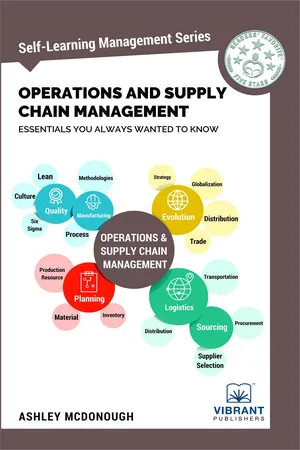
Operations and Supply Chain Management Essentials You Always Wanted to Know
Master Key Concepts, Procurement, Logistics, and Supply Chain Optimization
- English
- ePUB (mobile friendly)
- Available on iOS & Android
Operations and Supply Chain Management Essentials You Always Wanted to Know
Master Key Concepts, Procurement, Logistics, and Supply Chain Optimization
About this book
Master Key Concepts, Procurement, Logistics, and Supply Chain Optimization. A practical understanding of the dynamic, expanding, and evolving Supply Chains that make our daily lives possible.
After reading this book, you will be able to answer the following questions:
- What is Operations and Supply Chain Management and why is it important?
- What are the key functions within this field, and how do they interact with one another and the broader business?
- What are the responsibilities and decisions that managers in each functional area think about?
- How will disruptions in the Supply Chain impact the business world and our lives?
Have you ever wondered what your peers meant by "Supply Chain" or "Operations", or why either of these fields matter? What about people that work in these roles - what do they actually do? In Operations and Supply Chain Management Essentials, these questions and more will be answered.
This useful guide uses a hypothetical company and the consumer product they make, to explain how the various functions within the Supply Chain intertwine to bring a finished product to life for consumers in the market. You will understand the story of how new demands, changing preferences, and unforeseen circumstances force this fictional company to adapt in order to survive. Through this book, you will understand and appreciate how these activities, including logistics and warehouse management, make everyday products and services available at our disposal - and why this is increasingly important for companies to pay attention to. The simple format and non-technical language of this book will attract even laypersons looking for a quick, comprehensive overview of supply chain management.
About the Series
The Self-Learning Management Series is designed to help stud
Frequently asked questions
- Essential is ideal for learners and professionals who enjoy exploring a wide range of subjects. Access the Essential Library with 800,000+ trusted titles and best-sellers across business, personal growth, and the humanities. Includes unlimited reading time and Standard Read Aloud voice.
- Complete: Perfect for advanced learners and researchers needing full, unrestricted access. Unlock 1.4M+ books across hundreds of subjects, including academic and specialized titles. The Complete Plan also includes advanced features like Premium Read Aloud and Research Assistant.
Please note we cannot support devices running on iOS 13 and Android 7 or earlier. Learn more about using the app.
Information
Quality


Quality Programs

Table of contents
- What is Supply Chain and Operations Management? 9
- Planning and Control Systems 17
- Procurement, Purchasing, and Sourcing 26
- Manufacturing 33
- Quality 44
- Logistics 59
- Supply Chain Evolution 68
- Supply Chain in the Modern World 76
- What is Supply Chain and Operations Management?